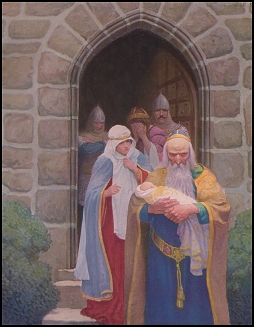

King Arthur & the Matter of Britain
Sources ·
History & Archaeology ·
Welsh Bards ·
Malory ·
Arthur ·
Gawain ·
Guenevere ·
Percival ·
Merlin ·
Tristan & Iseult ·
Elaine of Astolat
 The
prophet Merlin, a clever synthesis based on far
more ancient characters, first appears c. 1135 in Geoffrey of
Monmouth's Historia Regnum Britanniae or History
of the Kings of Britain; Geoffrey also wrote a
Vita Merlini (Life of Merlin) and
added a sequence of "Merlin's Prophecies" to later
versions of his Historia.
The
prophet Merlin, a clever synthesis based on far
more ancient characters, first appears c. 1135 in Geoffrey of
Monmouth's Historia Regnum Britanniae or History
of the Kings of Britain; Geoffrey also wrote a
Vita Merlini (Life of Merlin) and
added a sequence of "Merlin's Prophecies" to later
versions of his Historia.
Geoffrey blended two older
story-strands: a long-lived British folkloric tradition of
a "Wildman of the Woods," sometimes called Lailoken and, later,
Myrddin, and a story
from Nennius' Historia
Brittonum or History of the Britons
of a fatherless boy called Ambrosius who prophesies
the doom of King Vortigern. This composite character
Geoffrey called
"Merlin Ambrosius" is the source for the Merlin
the Magician we know today.
Merlin & the History of Britain
In Geoffrey's conception, Merlin is the son of a
nun of royal birth, engendered by a demon; this
half-human origin becomes over time the source of
Merlin's prophetic powers. In Robert de Boron's
old French verse Merlin, he "plays a redemptive role
as mediator between earthy chivalry and the heavenly
plan of salvation: he oversees the conception of Arthur,
creates the symbolism of the Round Table, and prepares
Perceval for the Grail quest" (William W. Kibler,
The Arthurian Encyclopedia, Garland Press 1986).
Merlin's position in the popular imagination as a great seer
was secure from Geoffrey's time onward; political
"prophecies of Merlin", tuned to the times, were still
being published well into the seventeenth century, the
best known perhaps being The Life of Merlin,
Sirnamed Ambrosius. His Prophesies, and
Predictions Interpreted; And Their Truth
Made Good by Our English Annalls. Being a
Chronographicall History of All the Kings,
and Memorable Passages of This Kingdome,
from Brute to the Reigne of our Royall
Soveraigne King Charles, written by Thomas Heywood
in 1651.
Resources
Myrddin/Merlin
by Thomas Green at his Arthurian Resources
site summarizes the pre- and post-Geoffrey of Monmouth Merlin cycles.
New !
Merlin
and
Geoffrey of Monmouth,
at the Camelot Project.
Merlin
and Nimue
at Britannia.
The Prophecy of
Merlin (Dublin MS), edited by James M. Dean, from
Medieval English Political Writings, at TEAMS.
Arthurian
Passages from the History of the Kings of Britain by
Geoffrey of Monmouth,
edited and translated by J.A. Giles, D.C.L., at the Camelot Project.
Nennius'
Historia Brittonum at The
Internet Medieval Sourcebook, part of ORB,
the Online Reference Book for Medieval Studies.
Prose Merlin,
a late medieval Arthurian work written near the middle of the fifteenth century,
edited by John Conlee, with an introduction, at TEAMS.
Essays and Commentary
Some
Notes on Merlin by C. Scott Littleton and Linda A. Malcor,
from Arthuriana.
Ancient
Echoes: Transformations of Celtic Mythology in Arthurian Legend,
part of the Quest at the University of Idaho.
Historiography of the Middle Ages, 400-1200:
Dark Rooms and Dry Straw by
Sheila Brynjulfson at Vortigern Studies.
Geoffrey
of Monmouth, an article by Rod Hampton at
Britannia.
Historia Brittonum,
an annotated essay on Nennius and the Historia by
Robert Vermaat at Vortigern Studies.
Concerning the Name Myrddin by
Heather Rose Jones at Medieval Scotland.
New !
Curiosities
Sir
Gowther, a poem found in two late fifteenth-century manuscripts,
tells the tale of the half-brother of Merlin. The Introduction discusses
the intricate interplay of source-material that built this legend.
A
Famous Prediction of Merlin, the British Wizard by Jonathan Swift,
1709.
The Boy Apprenticed to an Enchanter,
a novella by Padraic Colum.
The
Birth of Merlin, or, The Childe Hath Found His Father,
a play of c. 1620, first published in 1662 as by "William Rowley
and William Shakespeare"; modern scholars doubt that Shakespeare
has any hand in it.
Top ·
Home ·
Colophon ·
Notes on the Illustrations ·
Site Map
4 July 2004


 The
prophet Merlin, a clever synthesis based on far
more ancient characters, first appears c. 1135 in Geoffrey of
Monmouth's Historia Regnum Britanniae or History
of the Kings of Britain; Geoffrey also wrote a
Vita Merlini (Life of Merlin) and
added a sequence of "Merlin's Prophecies" to later
versions of his Historia.
The
prophet Merlin, a clever synthesis based on far
more ancient characters, first appears c. 1135 in Geoffrey of
Monmouth's Historia Regnum Britanniae or History
of the Kings of Britain; Geoffrey also wrote a
Vita Merlini (Life of Merlin) and
added a sequence of "Merlin's Prophecies" to later
versions of his Historia.